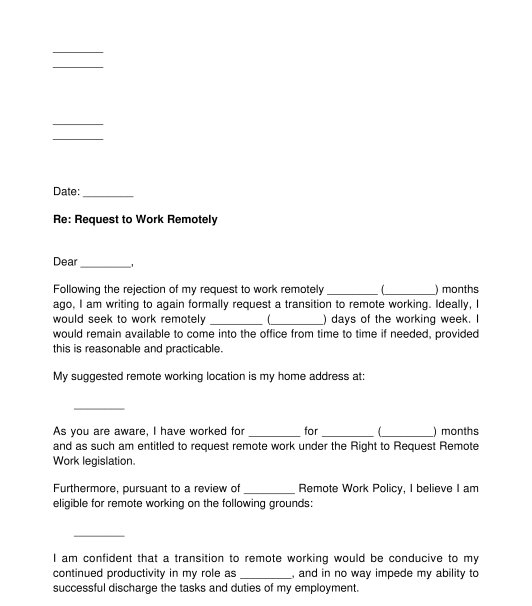 15/09/2025
15/09/2025

Answer a few questions and your document is created automatically.

Your document is ready! You will receive it in Word and PDF formats. You will be able to modify it.

 15/09/2025
15/09/2025
 Word and PDF
Word and PDF
 1 page
1 page
This Letter Requesting Remote Work is designed to request a remote work from their employers.
The employer has the right to reject the request, but only on legitimate business grounds, some grounds include: employee's productivity, health and safety concerns and data protection concerns. This letter pre-emptively addresses those factors which may incline the employer to refusing a request. It provides space for the employee to articulate why their productivity, health and safety and other business responsibilities will remain in tact during periods of remote work.
Employees can request to work exclusively remotely or request a 'hybrid' work arrangement, by which they spend some days in the office and some days working remotely. This document allows users to specify the type of working arrangement they would ideally like. It should be remembered that this Letter Requesting Remote Work is just that, a request. The user should express their ideal preferences which the employer can subsequently accept or reject. It is the first offer in a negotiation. If the employer is unhappy with a particular term they can present a counter offer that is more amenable to their business needs.
The Right to Request Remote Working Bill requires employees to list the reasons why they want to work away from the office. There are any number of factors why an employee might wish to work remotely and this document provides ample space to elaborate the reasons prompting the request. Employers want happy employees, so it is advised that employees be as detailed as possible and outline all the benefits that remote working would bring to them personally and how it would facilitate their lifestyle.
Employers have 30 days to respond to the request. They may accept the employee's proposal in full, agree to remote working on adjusted terms or reject it. If the request is refused the employer must present business grounds why remote working is not a viable option for the current employee. As stated, this letter is designed to pre-empt any of the typical business concerns that would prevent remote working. However, if the request is denied, employees can apply for remote working again in 12 months time. Or if the employee considers the employer's decision to be unfair, unreasonable or in any way discriminatory, they can make an appeal to the Workplace Relations Commission. This final course of appeal offers a strong safety net for employees. It means that employers are highly encouraged to grant requests for remote work if it can be at all accommodated.
This document can be used by any employee who seeks to perform the tasks of their employment remotely, on a full or part time basis. The only caveat is that employees should be employed with their current employer for at least six months to be lawfully entitled to request remote work under the present Bill. Some employers may extend this right to all employers, however it is at their discretion. It is therefore advised that employees employed for shorter periods consult their Employee Handbook to identify their employer's stance on this.
The Right to Request Remote Work Bill strongly encourages all businesses to have a dedicated Remote Work Policy in place. It is advised that that the user consult this document when filling in the template to ensure that any of their employer's concerns or preferences are addressed.
This document is written in compliance with the law of Ireland.
You fill out a form. The document is created before your eyes as you respond to the questions.
At the end, you receive it in Word and PDF formats. You can modify it and reuse it.
Letter Requesting Remote Work - sample template
Country: Ireland